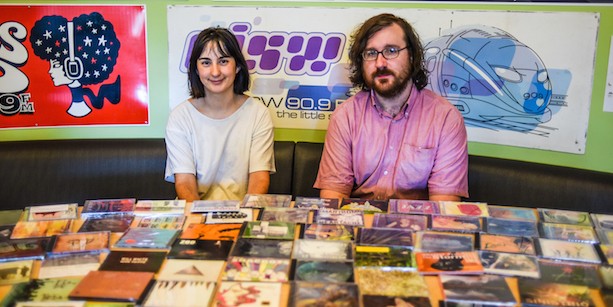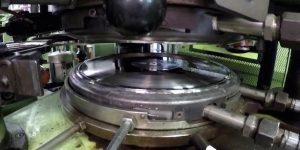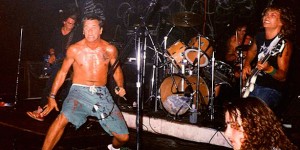 Music
Music
Calgary radio station CJSW launches Local Music Library
by Michael Rancic
May 5, 2016
The collection representing 30 years of Calgary music is available at local library branches.
Photos: Michael Grondin
What does a music scene’s memory look like? For Kerry Maguire, host of Some Velvet Mornings on Calgary campus radio station CJSW, it looks like a library. Maguire pitched the idea, originally conceived by Station Manager Myke Atkinson, to the Calgary Public Library, coordinating a collection of lendable local music releases that will travel between eight of the system’s 17 branches.
The Local Music Library installation will consist of releases curated by musician/Bug Incision label head/promoter Chris Dadge (Lab Coast, Chad VanGaalen, and countless other collaborations). 250 local music offerings on CD are available, representing the last 30 years of the city’s musical history. It will also include a listening station so that interested parties can take their time and dig into the material before they choose what to sign out.
We spoke with Maguire ahead of the library’s free, all-ages official launch party on May 7th at Calgary’s Memorial Park Library to learn a bit more about the inspiring project, its aims, and how she got it off the ground. Listen to a few samples of rare releases available in the Local Music Library and read on for the interview.
AUX: Your inspiration to start this project was based on the wealth of local music material people didn’t have access to?
Kerry Maguire: Whenever we give people tours of the radio station, the library is always the last thing you see. So first you walk into the volunteer area, then there’s the offices and the production room, and the last thing you step into is the Chad Saunders music library. It’s amazing. There are 70,000 albums in there. It’s always the part that people are amazed by. So I wanted to share part of that with people.
What was the motivation to keep the Local Music Library physical?
I feel like it doesn’t have the same effect digitally. When you encounter that same amount of music as digital information it gets overwhelming, in a more anxious way. But whenever you’re in any kind of library, there’s a sort of awestruck feeling more than an “ugh there’s so many things to listen to.”
A few of the CDs for the collection were specially printed because they didn’t exist anymore in physical form. So much of the experience of listening to music involves looking at the liner notes, the images, seeing where it was recorded. There are so many interesting things you can learn from the actual CD case even before you even put the CD in a player.
Another cool thing about them being physical is that we’ve put these little stickers on them that have the artist, the album title, the label, the year it came out, the genre and a 60-word description which we had a lot of fun doing. So it’s like “this person was in this band but they were also in this band and this band. They were influenced by this other band.” Hopefully those stickers will help people make connections throughout the collection.
A selection of titles available in the Local Music Library.
That’s great. How long did all of that take to do?
It took a really long time. It took the most time out of anything. I think it’ll be totally worth it though. I had Chris Dadge helping me. He’s an incredible music dictionary. He basically wrote most of the labels off the top of his head. He works at a record store and is a very prolific and involved musician here in Calgary. He was the brains behind that. It’s amazing to watch him write about everything. It took us about a month, a total of 200 hours to do that.
How are the CDs presented?
We’re just doing it alphabetically to keep things simple. We’re not going to arrange anything by genre. So the front side of the cabinet will have all of the CDs in it, and on either side we have digital photo frames. They’ll be showing all these little ephemeral things that we’ve scanned and hope to display alongside all the CDs, so people can listen and look at cool stuff. I’ve been simultaneously collecting show posters and there’s this record label here called Saved By Radio that made trading cards of all the members of the bands that were on their label at one point in time,
Take me through the process of how you got it all organized. How did you end up partnering with the library?
Partnering with the library was the first part. We always wanted to partner with the library. The way I’ve been thinking about it is that we’ve always had this kind of aural reach over Calgary, so we can reach the far corners of the city with our voices and music, but the library has this amazing face to face relationship with the city. They understood that and so we are making a pretty big effort to not keep the collection in one place.
The branches the collection will visit are strategically picked so that they’re all over the city. Calgary has some pretty crazy urban sprawl, as you may or may not know. So there are many branches that are very far away from the downtown core but are still in Calgary. Places with demographics that maybe musicians wouldn’t normally have access to. It’s really cool that the library has this relationship with these communities that we might have through the airwaves but these musicians are never playing in, like this great neighbourhood called Saddletowne, that’s like 15 kilometres from downtown Calgary.
So the library loved the idea from the start?
They’ve been so great to work with. I think after Toronto, the Calgary public library is the second most used library system in Canada, and sixth most used system in North America. I have some cool facts. I cold called them and was like “Hello! I work at CJSW. Would you be interested in doing this thing with us?” and they said yes, which is great. I’ve been working with a bunch of the collections people there, the event planning people there and they’ve all been amazing. We’d never worked with them previously, and when we were envisioning this project we were thinking “wouldn’t it be great if it was at the library?” and then that’s where it’s going to be. It worked out really well.
You also managed to get funding for this project?
Yeah, it was a project grant. There’s this funding body called the Calgary Foundation. A project grant is something that has definite start and end date. They have different impact areas, so one of them is arts and culture, another focuses on history as well. So yeah, we gave our proposal, and our budget. I really like their process, because it’s a Calgary-based foundation, so they’re able to do in-person interviews. Because of that we were able to show them the radio station, the CDs, the tables that are being made by the same person who is going to make the shelf, and that was really great. They’re covering everything.
Between “arts and culture” and “history” it sounds like you’re hitting a lot of their impact areas.
Yeah, and well we just had the Junos here, and there’s a general excitement about music in the city right now. Tourism Calgary has dubbed it “Calgary’s year of music” so it’s a good fit. A lot of these organizations have their ear to music right now, and we come along and say “hey! We know lots about music.”
How much of your collection is made up from the radio station’s, the library’s and donations?
All of our collection is from the donation drive we had. We’re trying to mirror the collection we have at the station. Unfortunately a lot of our CDs at the station are broken into these little paper sleeves to fit them all, so we had this huge donation drive. At first they were trickling in, but by the end we had 700 CDs to pick from. I still have 400 others. There were a lot of duplicates. It was amazing how many CDs we got, though. I’m very grateful. I wasn’t expecting that many. It was really fun to go through what people had.
Considering your project grant means you’ll have a set start and end date for this project, have you thought at all about what does success look like to you?
Success would be: getting someone who has never checked out the local scene before to do so. On the music side, exposing musicians to communities and audiences they’ve never performed for before. I think the local music library is also for people who are already involved in music. It reinforces the importance of the work that they’ve done by making this collection of CDs mirroring the community of people that made it. Giving legitimacy to the things they’ve done. If people feel that way then I think we’ve succeeded.
Tags: Music, Interviews, Calgary, campus radio, cjsw, local music library






